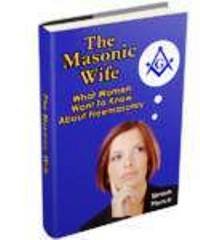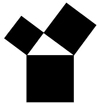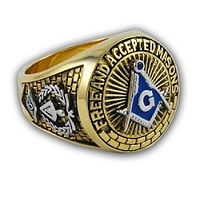
The Masonic Sheaf of Corn, in King Solomon's day, represented part of the wages reaped from the Master Masons' labors.
Today, it is used as a symbol of that time, long ago, mostly during the dedication, constitution and consecration of a new lodge and in the laying of cornerstones. At those times, the Masonic Sheaf of Corn represents the fruit of our labors, our sacrifices and all we have done to deserve them.
The "Plenty" of the Harvest:
Corn, wine and oil have been associated with "the Harvest" and "the Plenty" since King Solomon's time...and before.
Masonic Wages: When King Solomon requested of King Tyre the wood (cedar, fir and algum) which came from Lebanon, for which to build the Temple (Chronicles 2: 8), he promised payment of wheat, barley, wine and oil (Chronicles 2:10).
Masonic Charity: The Masonic Sheaf of Corn
represents charity to the less fortunate, as in these excerpts from the Bible.
"When thou cuttest down thine harvest in thy field, and hast forgot a sheaf in
the field, thou shalt not go again to fetch it: it shall be for the
stranger, for the fatherless, and for the widow: that the LORD thy God may
bless thee in all the work of thine hands." (Deuteronomy 24: 19)
"When thou beatest thine olive tree, thou shalt not go over the boughs again: it shall be for the stranger, for the fatherless, and for the widow." (Deuteronomy 24: 20)
"When thou gatherest the grapes of thy vineyard, thou shalt not glean it afterward: it shall be for the stranger, for the fatherless, and for the widow." (Deuteronomy 24:21)
Sheaf of Corn:
The Sheaf of Corn represented the "coin of the realm" to our ancient brethren, the people of Israel. While we are paid in dollars and cents, today,... corn, wine and oil were the wages of the fruits of their labors.
Most Masonic scholars believe that the Masonic Sheaf of Corn in our Masonic ritual actually represents the more generic term, meaning "grain", in general. This is why you sometimes hear mention of the Masonic Sheaf of Wheat, the Masonic Sheaf of Barley or the Masonic Sheaf of Grain used somewhat interchangeably.
Here in the United States, we usually think of corn as large hybridized cobs which are some shade of yellow, white or variegated yellow / white.
At Halloween, we see Indian maize used in decorative Fall harvest displays, but not usually in the grocery store for human consumption. Indian maize can be a solid color, but much of it is variegated colors of red, deep purple, dark yellow, light yellow, orange and almost white.
No one knows for sure whether "corn", as we know it in the United States, is the exact grain that the Hebrews in Israel during King Solomon's day grew for food, however Duncan's Masonic Ritual and Monitor, written by Malcolm C. Duncan in 1866, uses the word "corn".
The King James version of the Bible mentions the word "corn over 100 times. Whether this was a generic term to represent any grain used in breadstuffs or whether the name of the exact type of the grain was lost in one of the many translations of the Bible, is unknown.
Shibboleth: The word "Shibboleth", (in Hebrew: Sihlet-Shabioth) was used to distinguish friend from foe. It is the interpretation of the test word used by the troops of Jephthah to distinguish the Ephraimites after the battle on the banks of the Jordan.
The reason it was used as the test word is because the Ephraimites' dialect was somewhat different than the troops of Jephthah and if they pronounced the word incorrectly, they failed the test.
"Shibboleth" has two meanings:
- A place to cross the water (a waterford)
- Corn (or, generically, grain), which is an emblem of the germination force of the seed.
Note: There are also two jurisdictional interpretations of the word, Shibboleth: Some Grand Lodges use the word "waterfall" in lieu of the word "waterford".
Fruits of the Earth: However, in general it is believed that the Sheaf of Corn symbolizes the plentiful fruits of the Earth and those who are allowed to partake of them through hard work and knowledge.
As you leave the Fellow Craft to become a Master Mason, you receive the "plenty" when you:
- Cross the passages of the Jordan
- Learn the correct pronunciation of Shibboleth, and
- Pause within your own Middle Chamber.
"As Hiram prayed daily for guidance from his God before drawing the designs that would set the craftsmen to work, so must we. ...Each Master Mason becomes his own architect.
Each supervises the building of that "temple not made
by hands." Each builds into his structure beauty, harmony and knowledge to
the extent he is willing to work."
(...The Craft
and its Symbols, page 84, 1974, Allen E. Roberts, MaCoy Publishing and Masonic
Supply Company.)
Masonic Wages and Masonic Charity: The next time you pass under the Masonic Sheaf of Corn, remember
your ancient brethren, their hard work to receive the "plenty" as their wages and then,... as now, because of that hard work, the
Masonic charity your brethren is able to provide to the stranger, the fatherless, the
widow and those who are less fortunate.
The more you know, the more you grow within the craft.
Share Your Knowledge: Please share what you have just learned about the Masonic Sheaf of Corn with your newer members, so they, too, may reap the harvest of your knowledge.
Lodge Education Officers may choose to print it and discuss it at their Lodge Education meetings.
Related Pages:
Return from Masonic Sheaf of Corn to Freemason Symbols
5 Fast Methods To Find the Information You Want to Learn About
- Search Box - Use the Search Box at the top of your page.
- Site Map - Use my Site Map page to find the topics you are most interested in.
- Carousel - Use the carousel of pages at the top of your screen.
- Menu Icon - On MOBILE, click the MENU button at the top of each page.
- Masonic Books - Browse through a selection of Masonic books.






